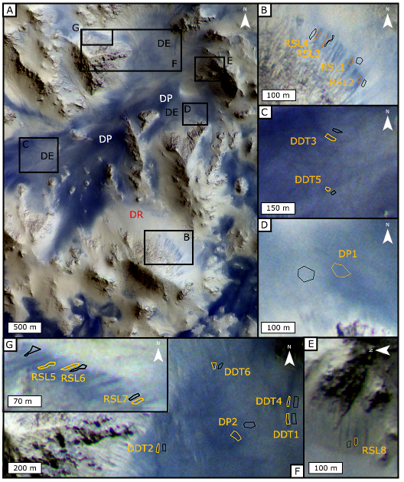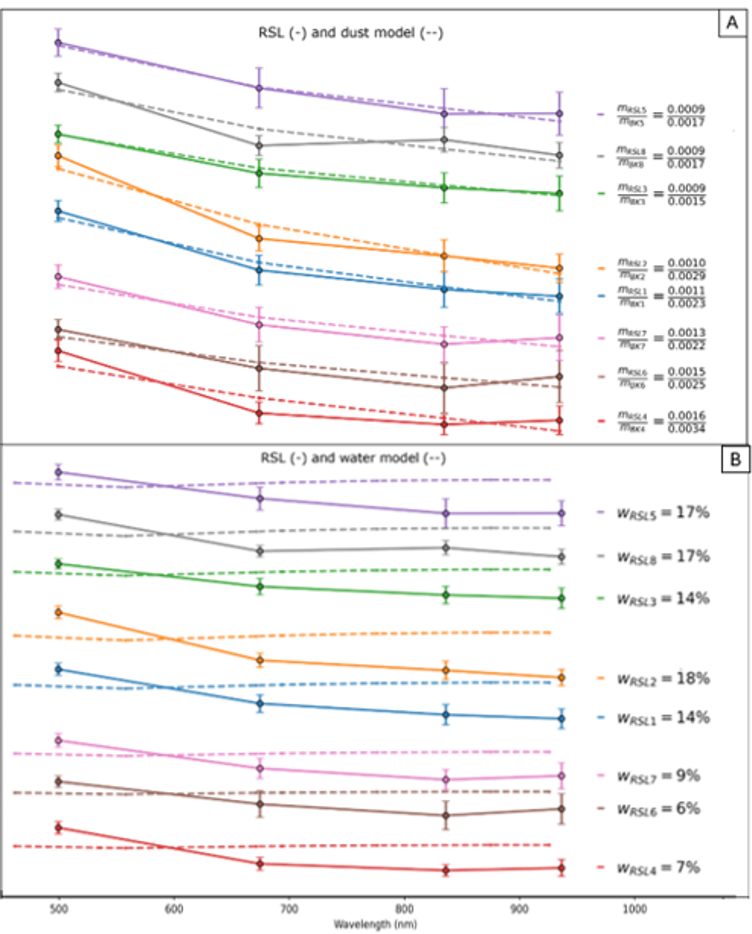Multiband photometry of Martian Recurring Slope Lineae (RSL) and dust-removed features at Horowitz crater, Mars from TGO/CaSSIS color observations
- 1INAF, Osservatorio Astronomico di Padova, Padova, Italy(giovanni.munaretto.1@phd.unipd.it)
- 2Department of Physics and Astronomy “G. Galilei”, University of Padova, Padova, Italy
- 3Center of Studies and Activities for Space "G. Colombo" (CISAS), Padova
- 4Inst. Space & Earth Exploration, Dept. Earth Sci., Western University, London, Canada
- 5Lunar and Planetary Laboratory, University of Arizona, Tucson, AZ, USA
- 6Physikalisches Institut Universitat Bern, Switzerland
- 7University of Colorado, Boulder, CO
Introduction: Recurring Slope Lineae (RSL) are narrow dark streaks that incrementally lengthen down Martian warm steep slopes [1]. On first approximation, they appear during the Martian summer, disappear in winter and recur annually. This temperature dependence suggested that RSL may be related to flows of liquid water or brines [1-5], possibly fed by groundwater sources [6, 7] or from the deliquescence of hygroscopic salts [8]. Alternatively, RSL have been interpreted as dry granular flows [9, 10, 11, 12], possibly related to aeolian processes [13, 14]. Although a detailed explanation of the RSL nature and formation mechanism is still not complete, the latest evidence points further toward a dry mechanism [15].
Here, we provide further evidence for a dry origin of RSL by investigating their colour properties through multiband photometry obtained from 4-filter Colour and Surface Science Imaging System (CaSSIS, [16]) observations at Horowitz crater, Mars. We compare it with multiband photometry of dark tracks left by the passage dust-devils (DDTs), which are dark marks left by the passage of whirlwinds, and regions where surface dust has been partially removed (“dust poor” regions, DPs). Since DDTs and DPs are being formed by ferric dust removal and the exposure of underlying, typically ferrous material, the comparative multiband photometry provided by CaSSIS may help us understand whether RSL are consistent with being formed by the removal of dust. This would contribute to show that RSLs are indeed dry flows of dust and sand. Our comparative photometry is then supported by a photometric modeling approach.

Figure 1 CaSSIS NPB (i.e., NIR PAN, BLU) colour composite showing the central peak of Horowitz crater and the location of the RSL, DDTs and “dust-poor” (DP) ROIs. “DR” indicate dust rich regions, “DE” indicate “dust-enriched” regions (i.e., with an intermediate dust content between DP and DR)
Methodology: We adapted the technique of [11,12] to compute the relative reflectance of RSL in the NIR (936.7 nm), RED (836.2 nm), PAN (675.0 nm) and BLU (499.9 nm) BLU CaSSIS filters. To do this, we select several regions of interest (ROIs) within RSLs, DDTs and DPs at Horowitz crater. The considered ROIs are shown in Fig. 1. We compute for each filter the RSL relative reflectance as in [11,12] and we repeat the procedure for DDTs and DPs. In our calculations, we apply a first order atmospheric correction by subtracting the I/F of the darkest pixel of each filter before computing the relative reflectance [16,17,18]. The relative albedo profiles are then compared with photometric models of dust deposition derived from the laboratory experiments of [19] and with mixtures of wet and dry martian terrain simulants derived from [20].
Figure 2. Relative albedo of A) RSL B) DDTs and C) DP ROIs with respect to nearby materials and D) corresponding average profile

Figure 3. A) RSL and best-fit dust models. The legend reports the estimated dust content for the RSL (numerator) and corresponding nearby material (denominator). B) RSL and best-fit water models. The legend reports the best-fit water content
Results: RSL, DDTs and DPs have similar relative reflectance profiles (Figure 2) within errors, i.e., they are all brighter in the BLU than in the PAN, RED and NIR filters. While there is some variability, there are no significant spectral features that characterize either RSL or DDTs or DPs in the latter three bands, where all show an approximately constant relative reflectance. In addition, photometric models of dust fallout provide significantly better fits than mixtures of dry and wet martian terrain simulants.
Discussion and conclusions: The comparison between relative photometry of RSLs, DDTs and DPs in the 4 CaSSIS filters show that these features have a quite similar relative reflectance profile, suggesting that they may have a similar origin. In particular, the higher BLU with respect to PAN, RED and NIR relative reflectance may suggest that the reflectance profiles of both features could be consistent with a ratio between a ferrous material (numerator), exposed by the removal of a ferric surface material such as the Martian dust (denominator). This picture is supported by comparison with photometric model of dust fallout, that consistently provide better fits to the observed relative reflectances than mixtures of dry and wet martian soils.
Acknowledgments: The authors wish to thank the spacecraft and instrument engineering teams for the successful completion of the instrument. CaSSIS is a project of the University of Bern and funded through the Swiss Space Office via ESA’s PRODEX programme. The instrument hardware development was also supported by the Italian Space Agency (ASI) (ASI – INAF agreement no. I/018/12/0), INAF/Astronomical Observatory of Padova, and the Space Research Center (CBK) in Warsaw. Support from SGF (Budapest), the University of Arizona (Lunar and Planetary Lab.) and NASA are also gratefully acknowledged. The study has been supported by the Italian Space Agency (ASI-INAF agreement no. 2020-17-HH.0).
References: [1] A. S. McEwen et al. (2011), Science (6043), 740–743 [2] Levy, J et al. (2012), Icarus, 219, (1), 1-4 [3] McEwen et al. (2014), Nat. Geosci. 7 (1), 53–58 [4] Stillman et al. (2014), Icarus 233, 328–341 [5] Huber et al., (2020) Icarus 335, 113385. [6] Stilllman et al. (2016), Icarus 265, 125–138. [7] Abotalib and Heggy (2019) ,Nat. Geosci. 12, 235–241 [8] Wang et al. (2020), Icarus 333, 464–480 [9] Dundas et al. (2017), Nat. Geosci. 10 (12), 903–907 [10] Schmidt et al. (2017), Nat. Geosci. 10 (4), 270–273 [11] Schaefer et al. (2019), Icarus 317, 621–648 [12] Munaretto et al. (2020), PSS 187, (2020), 104947 [13] Vincendon et al. (2019), Icarus 325, 115–127 [14] Dundas et al. (2020), Icarus 343, 2020, 113681 [15] McEwen, A. S. et al. (2021), JGR-Planets, in press. [16] Thomas et al. (2017) Space Sci. Rev. 212 (3–4), 1897–1944[17] Chavez Jr, P. S. (1988) .Remote sensing of environment, 24(3), 459-479. [18] Tornabene et al. 2018, SSR,214(1),18 [19] Wells et al., 1984, Icarus 58, 3, 331-338 [20] Gunderson et al 2007, PSS, 55, 10, 1272-1282
How to cite: Munaretto, G., Pajola, M., Lucchetti, A., Cremonese, G., Simioni, E., Re, C., Bertoli, S., Tornabene, L., McEwen, A. S., Becerra, P., Rangarajan, V. G., Valantinas, A., Pommerol, A., Thomas, N., and Portyankina, G.: Multiband photometry of Martian Recurring Slope Lineae (RSL) and dust-removed features at Horowitz crater, Mars from TGO/CaSSIS color observations, Europlanet Science Congress 2021, online, 13–24 Sep 2021, EPSC2021-379, https://doi.org/10.5194/epsc2021-379, 2021.